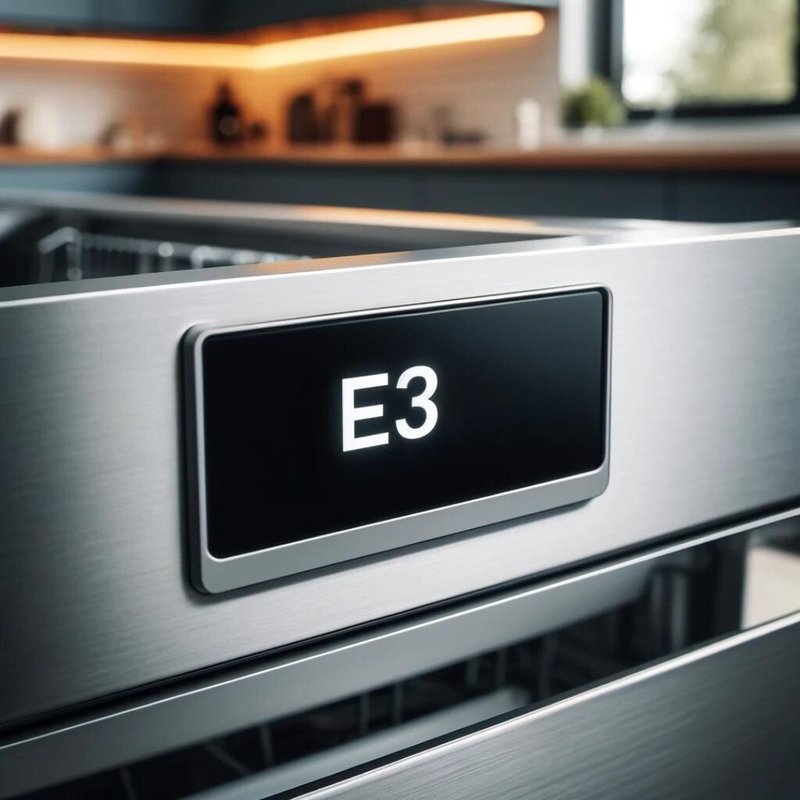
But what exactly does this error mean? In the simplest terms, the E3 code is your Bosch dishwasher’s way of indicating there’s an issue with heating the water. Dishwashers rely on hot water to clean and sanitize your dishes effectively. So, when there’s a problem with water heating, it’s essentially like trying to clean a car with a trickle of water instead of a powerful hose. Not quite as effective, is it? Let’s dig into what could be causing this hiccup and, more importantly, how you can fix it.
Understanding the E3 Error Code
The E3 error code is a specific signal that something within the dishwasher’s heating system isn’t working as it should. Think of it like your car’s check engine light, but for your dishwasher. Most of the time, it’s related to the dishwasher’s inability to heat the water to the necessary temperature. Bosch dishwashers are designed to heat the water to a certain level to ensure that your dishes come out sparkling clean and free of germs. When the heating component fails, the E3 error will flash on the display.
One common reason for the E3 code relates to the heating element itself. This component is like the kettle in a tea-making process. If your kettle doesn’t heat up, you won’t get a nice cup of tea—same goes, in a way, for your dishwasher’s water if the heating element is faulty. Another possible cause could be a thermostat failure. The thermostat monitors the water temperature, and if it’s not reading correctly, it might tell the dishwasher something’s off when it’s not, or vice versa.
It’s also worth considering the temperature of the water coming into your dishwasher. If your home’s water is exceptionally cold and the dishwasher can’t compensate quickly enough, it could think there’s a malfunction when it just needs more time or a boost in temperature. A little troubleshooting can usually help pinpoint the exact problem.
Exploring Common Causes
Now that we know what the E3 error is, let’s explore the common causes behind it. First up, the heating element itself. Over time, just like any appliance part, a heating element can wear out. Imagine trying to bake cookies with an oven that doesn’t heat up; just not gonna work out the way you want, right? If the heating element in your dishwasher is malfunctioning, it simply can’t heat the water to the necessary temperature.
The next suspect in our lineup is the thermostat. It’s like the brain of the heating operation, checking temperatures and giving the green light when things are good to go. If the thermostat is faulty, it might misread the temperature, either keeping the water too cold or triggering the E3 error unnecessarily because it thinks there’s an issue.
Water flow issues can also be a culprit. If your water supply is inconsistent or the inlet valve is clogged, which is similar to a clogged faucet chocking the water flow, it may lead to improper heating. A steady, reliable stream of water is crucial for the dishwasher to perform at its best.
How to Troubleshoot and Fix the E3 Error
Okay, we’ve identified potential culprits; now, let’s talk solutions. First, you want to turn off the dishwasher and unplug it—safety first! Check the heating element for any visible signs of damage. If you spot anything unusual, or if the element seems like it’s seen better days, it might be time to replace it. This is often something that might need a technician unless you’re particularly handy.
Next, look at the thermostat. You can test it with a multimeter to see if it’s working correctly. If it isn’t, a replacement is likely needed. Remember, a faulty thermostat is like using a broken thermometer, not helpful at all! For those comfortable with DIY projects, replacing a thermostat isn’t too daunting, but make sure you consult your dishwasher’s manual or a Bosch-specific guide.
Lastly, inspect the water inlet valve. Ensure there’s a good water flow; if it seems restricted, cleaning or replacing the valve might be the answer. Regular maintenance, such as cleaning your dishwasher’s filter and checking inlet hoses, can prevent these issues from cropping up in the future.
Preventing Future E3 Errors
To keep that dreaded E3 error at bay, there are a few preventative measures you can take. Regular maintenance is key. Think of it like keeping your car in good condition with regular oil changes and check-ups. Similarly, your dishwasher benefits from routine checks. Make sure to clean the filters regularly and inspect the inlet valve for blockages or damage.
Another tip is to ensure your water heater is set to an adequate temperature. You don’t want it too high or too low; somewhere around 120°F is usually ideal for most homes. This helps guarantee that your dishwasher starts with water at the right temperature, allowing it to reach optimal levels quickly.
Finally, consider running your dishwasher’s cleaning cycle with a dishwasher cleaner every so often. This helps keep the internal components free of limescale and detergent build-up, ensuring everything runs smoothly.
Taking these small steps can significantly reduce the chances of encountering the E3 error again and can extend the life of your beloved Bosch dishwasher. So next time E3 tries to play the villain, you’ll know exactly how to tackle it!